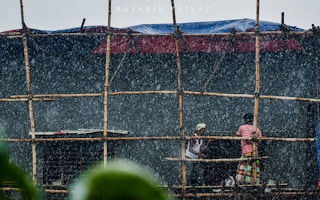Climate change could make much of South Asia - home to a fifth of the world’s population - too hot for human survival by the end of this century, scientists warned on Wednesday.
If climate change continues at its current pace, deadly heatwaves beginning in the next few decades will strike parts of India, Pakistan and Bangladesh, according to a study based on computer simulations by researchers at the Massachusetts Institute of Technology (MIT).
Key agricultural areas in the Indus and Ganges river basins will be particularly hard-hit, reducing crop yields and increasing hunger in some of the world’s most densely populated regions, researchers said.
“Climate change is not an abstract concept, it is impacting huge numbers of vulnerable people,” MIT professor Elfatih Eltahir told the Thomson Reuters Foundation.
“Business as usual runs the risk of having extremely lethal heat waves.”
The areas likely to be worst affected in northern India, southern Pakistan and Bangladesh are home to 1.5 billion people, said Eltahir, the study’s co-author.
“
Climate change is not an abstract concept, it is impacting huge numbers of vulnerable people.
Elfatih Eltahir, professor, Massachusetts Institute of Technology (MIT)
Currently, about 2 per cent of India’s population is sometimes exposed to extreme combinations of heat and humidity; by 2100 that will increase to about 70 per cent if nothing is done to mitigate climate change, the study said.
Heatwaves across South Asia in the summer of 2015 killed an estimated 3,500 people and similar events will become more frequent and intense, researchers said.
Projections show the Gulf region will be the world’s hottest region by 2100 as a result of climate change.
But with small, wealthy populations and minimal domestic food production requirements, oil-rich states in the Gulf will be better able to respond to rising heat than countries in South Asia, Eltahir said.
The study does not directly address migration but researchers said it is likely that millions of people in South Asia will be forced to move due to blistering temperatures and crop failures unless steps are taken to reduce greenhouse gas emissions.
Disaster experts from South Asian countries met in Pakistan last month to launch a toolkit to help city governments develop ways to manage the impact of heatwaves in urban areas.
Ahmedabad, in western India, has already introduced a heat action plan - South Asia’s first early warning system against extreme heatwaves.
Authorities in the city of 5.5 million have mapped areas with vulnerable populations and set up “cooling spaces” in temples, public buildings and malls during the summer.
This story was published with permission from Thomson Reuters Foundation, the charitable arm of Thomson Reuters, that covers humanitarian news, women’s rights, trafficking, property rights, climate change and resilience. Visit http://news.trust.org










